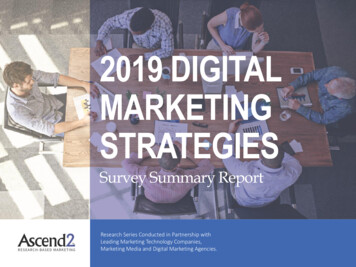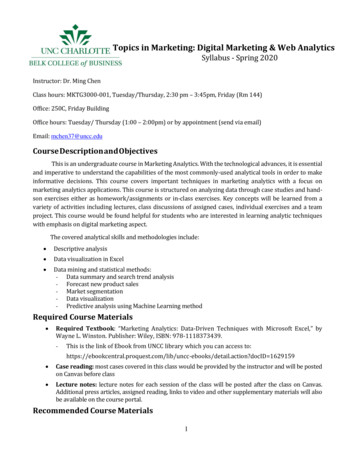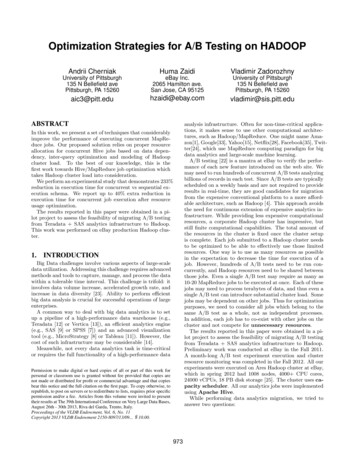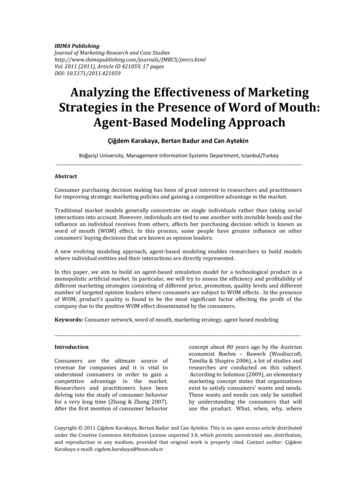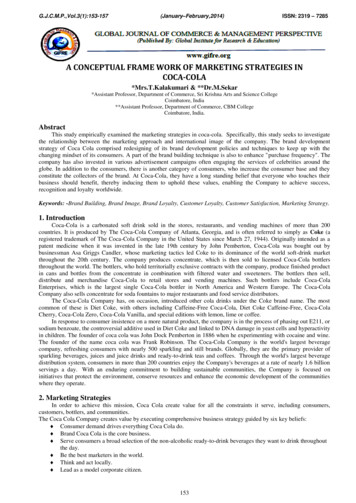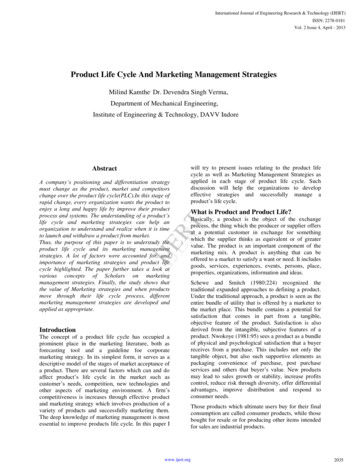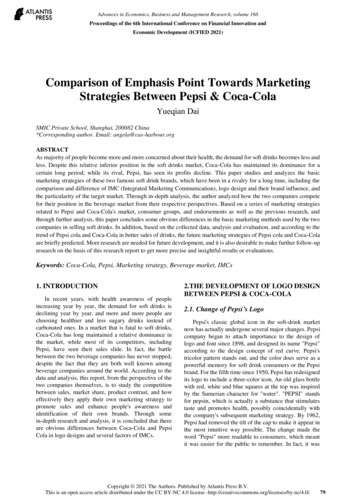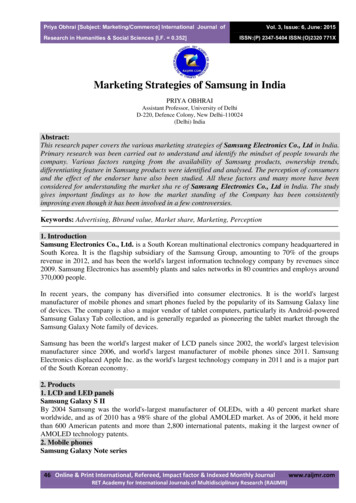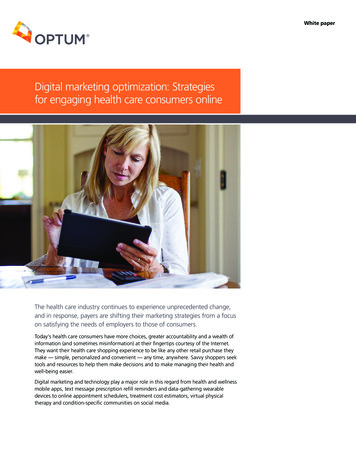
Transcription
White paperDigital marketing optimization: Strategiesfor engaging health care consumers onlineThe health care industry continues to experience unprecedented change,and in response, payers are shifting their marketing strategies from a focuson satisfying the needs of employers to those of consumers.Today’s health care consumers have more choices, greater accountability and a wealth ofinformation (and sometimes misinformation) at their fingertips courtesy of the Internet.They want their health care shopping experience to be like any other retail purchase theymake — simple, personalized and convenient — any time, anywhere. Savvy shoppers seektools and resources to help them make decisions and to make managing their health andwell-being easier.Digital marketing and technology play a major role in this regard from health and wellnessmobile apps, text message prescription refill reminders and data-gathering wearabledevices to online appointment schedulers, treatment cost estimators, virtual physicaltherapy and condition-specific communities on social media.
Digital marketing optimization: Strategies for engaging health care consumers online3 biggest fears of today’s generation and beyond123Low batteryNo wifiSlow bufferingSmartphones have replaced so many gadgets and everyday items in a consumer’s life,like alarm clocks, address books, cameras, photo albums and wallets, they’ve becomean indispensable extra appendage, not simply a mode of communication.What’s driving the need for digital marketing in health careConsumer demands are rising in four areas that impact digital:Instant gratification: Consumers want to access and exchange information anytime,anywhere, online and on-the-go.Innovation: Consumers want the disparate data from all their devices to be integratedinto a single view — they expect everything to connect and sync in real time and bedisplayed in a clean and clear dashboard.Personalization: Consumers expect you to know them and their needs and targetyour communications based on their preferences.Simplification: All interactions must be quick and easy.Growing application of digital tactics that support health care consumerismTODAY Online health insurance shopping Doctor email patients within secureapplications Pharmacy calls with prescriptionrefill remindersFUTURE Request medication fromsmartwatch Get a real-time text alert whenblood pressure is too high Receive one simple bill for care Consumer receives push messageon smartphone, e.g., fitnesschallenge ranking Build their own health plan, basedon their personalized needs, on theirinsurer’s website Health insurers provide freewearable for completing preventivescreening Have a single dashboard with alltheir health information Receive personalized messagesbased on their data to drive betterdecision-making and better healthHealth plans need to meet the consumer where they are online. For prospectivemembers, that may begin with an Internet search.Page 2
White paperToday’s health care consumers have more choices, greateraccountability and a wealth of information at their fingertips1 in 3American adults havegone online to figure out amedical condition1DialysisDialysisACAHysterectomyBlood testPregnancy47%HysterectomyChronic painFlurecallBlood testHospital painChronicHeart diseaseDrugDrugrecallHospitalHeart diseaseAlzheimer’sAlzheimer’sHigh blood pressureMedicaidMedicaidHigh blood pressureKnee surgeryLab workLab workMedicareACAAllergiesDiabetesFlu Diabetes AllergiesArthritisMedicareKnee surgeryThe most commonly researched topics are specific diseases or conditions,treatment options, doctors or other health professionals, and health care coveragein general as the below wordle illustrates.PregnancyWeight lossChild birthChild birthReference: Pew Internet & American Life ProjectArthritisWeight lossExchange consumers’ top reasons to choose a planHealth care is in the midst of a seismic shift toward more e-commerce, exchangesand consumerism, and digital marketing is a critical enabler. Exchange consumers aresearching and shopping online. Given that one-third of them switched their insurers for2015 coverage, it’ll be critical for health plans participating in the federal exchange tobuild awareness and brand preference to drive both acquisition and retention.It’s not surprising to see that premium cost is the top reason to choose a plan. With #2being benefits that meet a consumers’ needs, it’s critical for health plans to have aneffective strategy that promotes the benefits all year long (not just at renewal time) andthat sets them apart from other plans.of internet users searchfor information aboutdoctors and other healthprofessionals172%of internet users lookedonline for health informationin past year133%of consumers would trustGoogle or Amazon to delivertheir health care21. Pew Research. 2015.2. The birth of the health careconsumer. Strategy & Study. 2014With the reputation of company as #5, consumers are saying that brand or namerecognition is more important than customer service. This may seem hard to believe butit’s true. This creates a strong business case for ensuring a robust web presence, one thatallows the health plan to be found quickly and easily when consumers are doing research. #1Monthly plancost (premium)#4Provider network##2Benefits that meetmy health needs#3Out-of-pocketcosts5Name and reputationof insurance#6Customer serviceSource: Competiscan, LLC & Media Logic USA, LLC. 2015Page 3
Digital marketing optimization: Strategies for engaging health care consumers onlineMost helpful resources to drive consumer self-serviceWith the advent of DIY health, consumers are looking for resources that help them notonly select the best plan but also maximize the benefits after enrollment. They want theirhealth care shopping experience to be like any other retail purchase they make — simple,personalized and convenient — anytime, anywhere.While a dedicated phone line is vital, self-service is the new norm and transparency is key.To address the needs of savvy health care shoppers, payers must offer tools and resourcesto help them make decisions and to make managing their health and well-being easier.Consumers’ need for choice and transparency and their reliance upon technology arerequiring payers to adopt innovative ways of driving awareness and engagement.Consumers want their health insurer to include:Online account informationMake it easy to access account information from themember portal.Phone supportGive them a live person to chat with, especially importantif they haven’t found what they needed on the insurer’swebsite. What’s more, they expect the person on the otherend of the phone to know them and their situation.Physician ratings/reviewsPhysician ratings and reviews are imperative for comparisonshopping. If they can’t find this information on the insurer’swebsite, they will ask a friend or rely on recommendationson Angie’s List.Cost comparisonsLet them compare the cost of various options. They’d like todo that via an app, ideally.Email communicationsKeep them abreast of their benefits, the enrollmentdeadline, info about their HSA, etc.As we look at these top reasons, it’s clear that technology is playing a major role, includingcall center advancements, personalized services, mobile apps, data-gathering wearabledevices, online appointment schedulers and treatment cost estimators.Source: Competiscan, LLC & Media Logic USA, LLC. 2015Page 4
White paperHow web optimization through SEO and mobile can help addressconsumer needsConsumers are being asked to make more complex decisions. Many seek guidance frombrokers, navigators and other assisters in their community, while 61 percent do their ownresearch online for real-time information.61%of consumersdo their ownresearch onlinefor real-timeinformation.153%44%77%of exchangeconsumers visiteda health insurer’swebsite prior toselecting a plan.2of patients whoresearch hospitalson a mobiledevice scheduledan appointment.1of patients usesearch enginesprior to bookingan appointment.1Whether a health insurer participates on the exchange or not, they need to have strongbrand presence and points of differentiation to set themselves apart to compete for theattention of more sophisticated consumers and plan sponsors in the marketplace.For current members looking for providers and treatment options, insurers need to besure that information is easily found on their website, so members don’t have to turn toGoogle for answers.Search engine optimization (SEO) ranking factorsConsumers are using search engines such as Google to find the answers they seek; yourcompany site must appear on the first page of search engine results. People very rarelyclick to page two of the results or beyond. An SEO program can increase a site’s rankingand visibility in Google and other search engines. It also encourages easy web browsing.The algorithm for each search engine varies from site to site, but at a fundamental levelthere are five factors that get figured into the calculation and a website’s ranking: ContentCodeStructure linkPopularitySocial signalsContent is key. The importance of good quality, fresh, relevant content cannot beunderstated. Word count and Flesch-Kincaid readability are important factors toconsider — make information easy to read and digest for consumers.While there is a trend away from keywords and metadata and toward relevant content,they remain important factors. So insurers must ensure they get them right. Do somecompetitive research and use web analytic tools to understand the key words andphrases consumers use to find the website today.Hyperlink phrases that contain keywords. Focus on the user experience beyond thedesktop — mobile optimize the website — remember how many people are using theirtablets and smartphones. Sites must be search-engine friendly and well-integrated.Optimize images on your website.1. Think with Google’s The Digital Journey to Wellness: Hospital Selection2. Cometiscan, LLC & Media Logic USA, LLC. 2015Page 5
Digital marketing optimization: Strategies for engaging health care consumers onlineSocial signals, such as likes and retweets, can boost rankings while helping to enhancebrand awareness and drive organic traffic to top ranking sites.Lastly, link popularity is key. When other sites are linking to an alternate website, searchengines assume it has valuable content and deserves a boost in rankings. A suggestedstrategy is to seek out relevant bloggers, health and wellness alliances or partnerships. Keepa steady stream of news content out on the web because news sites tend to have morecredibility, and referral traffic from them carries more clout with Google.Whether handled in-house or if you hire an agency, be sure that whomever develops andmanages your SEO strategy has a thorough understanding of medical terminology and theneeds of health care consumers.And be sure to continuously monitor and modify your SEO tactics if you want to competewith other sites and stay on top of the rankings.Search engine marketingIf you don’t want to invest the time and energy in SEO, you can always buy your wayonto the first page of results — through pay-per-click ads and sponsored searches. Itis not always a cheaper option — in fact, it can be more expensive, depending on themarket, your competition and the number of clicks. However, it can be an effective tacticwhen time is of the essence, like open enrollment for the federal exchange, if you aren’totherwise ready for it.AdSponsored searchPage 6
White paperMobile optimization dos and don’tsOnce your site is well optimized for search engines, there are only a few additional thingsthat you need to think about when optimizing for mobile, keeping in mind that health careconsumers use their smart phones to read email and search the web.Mobile optimization generally consists of resizing and reformatting a site so that it canbe comfortably used on various browsers and screen sizes whether that’s a smart phone,tablet or personal computer.DODesign your site to be mobile-friendly. Mobiledevices are simplifying and revolutionizing the way sitesare designed. “Above the fold” no longer has meaningin a world where we scroll endlessly. Probably the mostimportant decision you’ll make when setting up a site isdeciding whether you want to use a responsive, dynamicserving, or separate site configuration. Each has itsadvantages and disadvantages. Google prefers responsivedesign but supports all three options as long as you haveset them up properly.Streamline the layout. For a small screen, minimizegraphics. This means designing as simple a site layout andHTML code as possible and using simple mechanisms forcore elements such as navigation and menu options like a“hamburger” menu.Again, content is key! Keep it simple — include only themost important content. Use web analytics to see the mostvisited pages and only serve up those when accessed via amobile device.Minimize text entry. In other words, design for the fatfinger. Touch-screen navigation can lead to accidental clicksif your buttons are too big, too small, or in the path of afinger that's trying to get the page to scroll.Page speed. Because of hardware and connectivity issues,page speed is even more important for mobile users thandesktop users. Beyond optimizing images, you’ll want tominify code, leverage browser caching and reduce redirects.Optimize titles and meta descriptions. Remember thatyou’re working with less screen space when a user searchesusing a mobile device. Be as concise as possible whencreating titles, URLs and meta descriptions.Use Schema.org structured data. Schema.org is acollaborative online community of developers who havecreated a common lexicon that helps webmasters maximizetheir site structure, which helps search engines rank on amore apples-to-apples comparison.Optimize for local search. If you’re vying for newmembers in a particular state, remember to optimize yourmobile content for
What’s driving the need for digital marketing in health care Consumer demands are rising in four areas that impact digital: Instant gratification: Consumers want to access and exchange information anytime, anywhere, online and on-the-go. Innovation: Consumers want the disparate data from all their devices to be integrated
